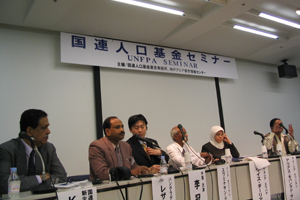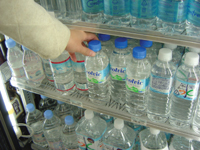Whither the Water?
Back to Contents of Issue: February 2004
|
|
|
|
by Dominic Al-Badri |
|
|
While the world's population has increased threefold over the past century, water use has increased by a factor of six. Already, 40 percent of the world's population live in areas with moderate to high water stress. (An area is defined as suffering from water stress when there is less than 1,700 cubic meters of water per person per year; similarly, water scarcity equates to less than 1,000 cubic meters of water per person per year.) Of that figure, 70 percent, or some 1.7 billion people, are in Asia. And that includes Japan.
"If present trends in water usage continue, two-thirds of the world's population will be living in water-stressed conditions as early as 2025," announced K.S. Seetharam, a specialist on population and development strategies at the United Nations Economic and Social Commission for Asia and the Pacific (UNESCAP). "The amount of fresh water in the world remains constant, but its uneven distribution, along with rising demand, is creating increasing scarcities."
Seetharam was speaking at a recent UN-sponsored "open forum" on population, gender and water in Kobe. Delegates from nine developing Asian countries, along with their Japanese hosts and nearly 200 members of the public, engaged in a marathon and at times heated session which brought to the fore how large a problem lies in store for Asia.
Both the Kansai and Kanto regions are defined as suffering from water stress, with supplies needing to be pumped in, which in Kansai's case means almost exclusively from the massive Lake Biwa, just east of Kyoto. However, the situation in Tokyo is expected to get even worse. Within the next 20 years or so, and certainly by 2025, Tokyo is expected to be classified as an area of water scarcity.
"Population growth, increasing consumption and economic production combine to exert heavy pressure on existing freshwater supplies," added Seetharam. "And these resources are further reduced and threatened by pollution and ecological degradation."
It's a vicious cycle, and one which many of Southeast Asia's rapidly growing countries are suddenly having to deal with: A fast-growing middle class sits side-by-side with a booming economic sector in Malaysia, for example, leading to a skyrocketing demand for fresh water. Kuanatan, a mid-sized city in Malaysia with a population of 400,000, is one such example.
"As a result of rapid urbanization in Kuanatan, the city's water authority now faces a shortage," said Alias Salleh, a seminar delegate from the city's municipal council. "By 2020, 65 percent of Malaysia's population will be living in urban areas, and already in Kuanatan we are unable to meet the demand for water. When potential investors realize this, they head elsewhere. It's a real problem."
"In Bangladesh, arsenic contamination in water is poisoning 35 million people [about 30 percent of the population], causing skin infections, skin cancer, blindness and physical disability," said Seetharam.
That some kind of global awakening is needed at all levels is becoming increasingly obvious. But with the ratification of the Kyoto Protocol increasingly precarious, the overall outlook for water as well as air isn't very good. And there are increasing worries about food production, due to the overwhelming dependence in the world on irrigation to ensure food security.
To grow one ton of grain, 1,000 tons of water are needed; twice that is required for the same amount of rice. In many parts of Asia, deforestation (in part due to increased urbanization) and the prevalence of water-intensive agriculture are hastening the depletion of existing water resources at rapid rates. In certain of India's regions, the level of the water table is declining by as much as three meters a year.
Asia is set to face major urban challenges in the coming decades: By 2025 more than 50 percent of the region's population will be living in urban areas. Municipal authorities in Kobe, which has long suffered a water shortage, stress the need for water conservation at all levels. The city is only able to supply about 20 percent of its daily water needs and is forced to pump in approximately 700,000 cubic meters per day. Kobe's uncompromising topography (only a third of the city can be classified as urban due to the Rokko mountain chain cutting Kobe's northern districts) further complicates matters for the water authority by increasing the range of solutions that need to be devised in order to ensure that all parts of the city are adequately supplied with fresh water.
The 1995 earthquake complicated matters yet again, as it brought home the importance of sustaining a safe water supply in the case of another such disaster. Lessons have been learned, and an emergency water supply plan and emergency storage system have been implemented across the city.
Compared with Tokyo residents, Kobe's citizens are relatively content. According to a survey carried out last May, half of the capital's population is unhappy with their tap water, and more than half refuse to drink it; in Kobe, nearly three-quarters of the population have no complaints.
Yet even this figure was too low for Syed Gias Uddin, the Managing Director of Water Supply and Sanitation in the Pakistani city of Faisalabad and another seminar delegate.
"Surely you have failed," he said. "All the people should be happy with their water supply in a country like Japan. In a developing country like mine I can understand it if people are not happy with the water, but in an advanced country like Japan -- and here in Kobe -- why are so many people drinking bottled French water?"
Concepts of branding and style carry no weight with delegates from countries where poor women in rural areas spend hours every day collecting water, adversely affecting their productive potential and their health -- or where children in areas lacking potable water suffer from water-related diseases like cholera, hepatitis, malaria, diarrhea and arsenic poisoning.
Though it seems to have crept up on many people in the developed world, the issue of water scarcity is one of some urgency. In the final analysis, it can best be tackled in both developed and developing countries through education programs at school and the propagation of water conservation initiatives aimed at adults -- like the one Kobe has -- imploring its citizens to not waste water.
"The earth is facing a serious water crisis, but it all comes down to individual responsibility," said Seetharam. "Water is a very valuable and scarce resource. Each individual must be conscious of the need to use it both responsibly and judiciously." @
|
|
Note: The function "email this page" is currently not supported for this page.


 MUCH HAS BEEN MADE in recent years of the population problem the world faces, but until relatively recently, the more serious issue of the world's water supply has received scant attention outside of specialists' circles. Only 1 percent of the world's water is available for consumption; 97 percent is accounted for by the oceans and seas of the world, and a further 2 percent is locked up in glaciers and permanent snow.
MUCH HAS BEEN MADE in recent years of the population problem the world faces, but until relatively recently, the more serious issue of the world's water supply has received scant attention outside of specialists' circles. Only 1 percent of the world's water is available for consumption; 97 percent is accounted for by the oceans and seas of the world, and a further 2 percent is locked up in glaciers and permanent snow.
 Pollution is a major worry, as it comes in so many different forms: Freshwater resources are degraded by ground water contamination, salinization and both industrial and human waste. Every year, an estimated 300-500 million tons of heavy metals, solvents and toxic sludge enter the world's water supply in the form of industrial by-products. In developing countries, 70 percent of this industrial waste is dumped untreated into waters where it pollutes the usable water supply. Water pollution is closely linked to the decline of freshwater species in all parts of the world -- and to all manner of health-related issues.
Pollution is a major worry, as it comes in so many different forms: Freshwater resources are degraded by ground water contamination, salinization and both industrial and human waste. Every year, an estimated 300-500 million tons of heavy metals, solvents and toxic sludge enter the world's water supply in the form of industrial by-products. In developing countries, 70 percent of this industrial waste is dumped untreated into waters where it pollutes the usable water supply. Water pollution is closely linked to the decline of freshwater species in all parts of the world -- and to all manner of health-related issues.



